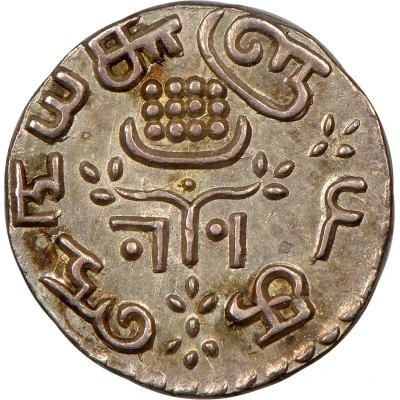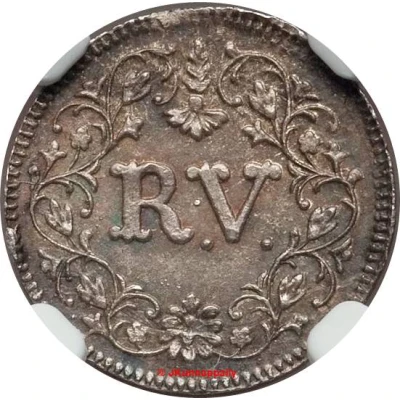


© NGC World coin guide
1 Fanam - Ayillyam Thirunal Rama Varma IV ND
| Silver | 1.5 g | 13 mm |
| Issuer | Kingdom of Travancore (Indian Hindu Dynasties) |
|---|---|
| Type | Standard circulation coin |
| Years | 1860-1861 |
| Value | 1 Fanam (⅐) |
| Currency | Rupee (1729-1947) |
| Composition | Silver |
| Weight | 1.5 g |
| Diameter | 13 mm |
| Shape | Round |
| Orientation | Medal alignment ↑↑ |
| Demonetized | Yes |
| Updated | 2024-10-05 |
| Numista | N#43436 |
|---|---|
| Rarity index | 79% |
Reverse
Crescent below twelve pellets considered as representing the 12 'Rasi' or the signs of the zodiac. Below that flower stalks with a dot in the middle Legend in Tamil: Date and 'pa ka' (for panam one) surrounds.
The lettering for the Reverse is in the Comments field below.
Translation: 1036 (malayalam era date), 1 fanam
Edge
Plain
Comment
- Ayilyam Thirunal Rama Varma (1832–1880) was the ruler of the princely state of Travancore in India from 1860 to 1880. His reign was highly successful with Travancore gaining the appellation of "model state of India". Ayilyam Thirunal was the nephew of Uthram Thirunal and Swathi Thirunal and grandson of the celebrated Gowri Lakshmi Bayi.Predecessor: Uthram Thirunal
Successor: Visakham Thirunal
Born: March 14, 1832
Died: May 30, 1880 (aged 48)
House: Venad Swaroopam
Dynasty: Kulasekhara
Father: Punartham Thirunal Rama Varma Koil Thampuran
Mother: Gowri Rukmini Bayi
Religion: Hinduism
- Also known as 'Tamil panam' (Tamil money) in Malayalam because of the Tamil script on the coin.
Interesting fact
One interesting fact about the 1 Fanam coin from the Kingdom of Travancore is that it features a unique blend of Indian and European design elements. The obverse side of the coin bears the image of Ayillyam Thirunal Rama Varma IV, the ruler of the kingdom at the time, in a traditional Indian style. However, the reverse side features a depiction of a British lion, reflecting the influence of British colonialism on the kingdom. This blending of styles is a testament to the cultural exchange and fusion that occurred during this period in Indian history.



